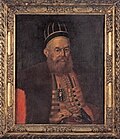Souliotes
The Souliotes (Greek: Σουλιώτες) are the bilingual Greek people of a village confederation called Souli (Greek: Σούλι).[2][3] They lived in the mountains of Epirus in northwestern Greece.[3] Souliotes fought in the Greek revolution of 1821 against the Ottoman Empire and its allies.[4]
Σουλιώτες | |
|---|---|
 A Souliot in Corfu Nikolos Pervolis by French painter Louis Dupré (1827). | |
| Languages | |
| Spoken Languages: Tosk Albanian, Greek; Written Language: Greek[1] |
Name
The origins of the name Souli are unclear.[5]
Languages
Souliotes spoke Greek and a southern dialect of Albanian called Tosk.[1] They only used Greek in their writings.[1]
History
Ottoman oppression forced Greek herders in Epirus to flee to the mountains during the end of the 16th century and the beginning of the 17th century.[6] There, they built a confederation of villages called the Tetrachori (Greek: Τετραχώρι, "Four Villages") also known as Souli.[7] The Souliotes resisted Ottoman rule during the 18th century.[8] They later participated in the Orlov Revolt, a failed Greek anti-Ottoman uprising that happened in the 1770s.[8]
When the Souliotes were betrayed to the Ottomans in 1803, some abandoned Souli while others killed themselves.[9] Among those who killed themselves were the women of Souli who threw themselves and their children off a cliff called Zaloggo in an event called the Dance of Zaloggo (Greek: Χορός του Ζαλόγγου).[9][10] During the Greek revolution of 1821, the Souliotes defeated the Ottomans at the battle of the Five Wells in September of 1821.[11]
Gallery
Flag of Greek leader Markos Botsaris raised in Souli in October 1820. The flag shows Saint George and in Greek says: "Freedom", "Fatherland", "Religion".
Souliotes Media
Captain of Suliote Albanians by Joseph Cartwright, published in March 1822.
Portraits of Lambro the Suliote and the old Balouk-Bashee of Dervitzina (Thomas Smart Hughes, 1820).
A Suliote in his shaggy Capote (Joseph Cartwright, 1822).
Ali Pasha of Yannina in a portrait by Spyridon Ventouras.
The Souliote women. Romantic painting by Ary Scheffer (1795–1858), depicting the folklore suicide of Souliote women known as the Dance of Zalongo during the Souliote wars (1827, Oil on canvas, Musée du Louvre, Paris, France).
References
Citations
- ↑ 1.0 1.1 1.2 Protopsaltē 1983, pp. 15–18.
- ↑ Karastathis 2014, Chapter V, Section 12: "Δίγλωσσοι οἱ Σουλιῶτες, ἀλλὰ χωρὶς καμιὰ συγγένεια μὲ τὰ ἀλβανικὰ φύλα".
- ↑ 3.0 3.1 Protopsaltē 1983, pp. 5–8.
- ↑ Protopsaltē 1983, pp. 13–14.
- ↑ Pappas 1991, p. 24.
- ↑ Protopsaltē 1983, p. 5–6, 23.
- ↑ Protopsaltē 1983, pp. 5–6.
- ↑ 8.0 8.1 Protopsaltē 1983, pp. 26–27.
- ↑ 9.0 9.1 Protopsaltē 1983, pp. 10–11.
- ↑ Royal Society of Canada 1943, p. 100; International Folk Music Council 1954, p. 39; Papaspyrou-Karadēmētriou, Lada-Minōtou & Ethniko Historiko Mouseio (Greece) 1994, p. 47; Pritchett 1996, p. 103.
- ↑ Protopsaltē 1983, p. 13.
Sources
- International Folk Music Council (1954). Journal of the International Folk Music Council, Volumes 6-10. Cambridge: Published for the International Folk Music Council by W. Heffer & Sons.
- Karastathis, Kostas V. (2014). Έλληνες απο το Αρβανόν [Greeks from Arvanon] (in Greek). Athens: Athos. ISBN 9789604951420.
{{cite book}}: CS1 maint: unrecognized language (link) - Papaspyrou-Karadēmētriou, Euthymia; Lada-Minōtou, Maria; Ethniko Historiko Mouseio (Greece) (1994). The National Historical Museum. Athens, Greece: Historical and Ethnological Society of Greece. ISBN 960-85573-0-5.
- Pappas, Nicholas (1991). Greeks in Russian Military Service in the Late 18th and Early 19th Centuries. Thessaloniki: Institute for Balkan Studies.
- Pritchett, William Kendrick (1996). Greek Archives, Cults, and Topography. Amsterdam: J.C. Gieben. ISBN 90-5063-147-9.
- Protopsaltē, E. G. (1983). ΣΟΥΛΙ - ΣΟΥΛΙΩΤΑΙ [SOULI - SOULIOTES] (in Greek). Athens: Library of the Epirotic Company of Athens.
{{cite book}}: CS1 maint: unrecognized language (link) - Royal Society of Canada (1943). Mémoires de la Société Royale du Canada. Ottawa: Royal Society of Canada.










